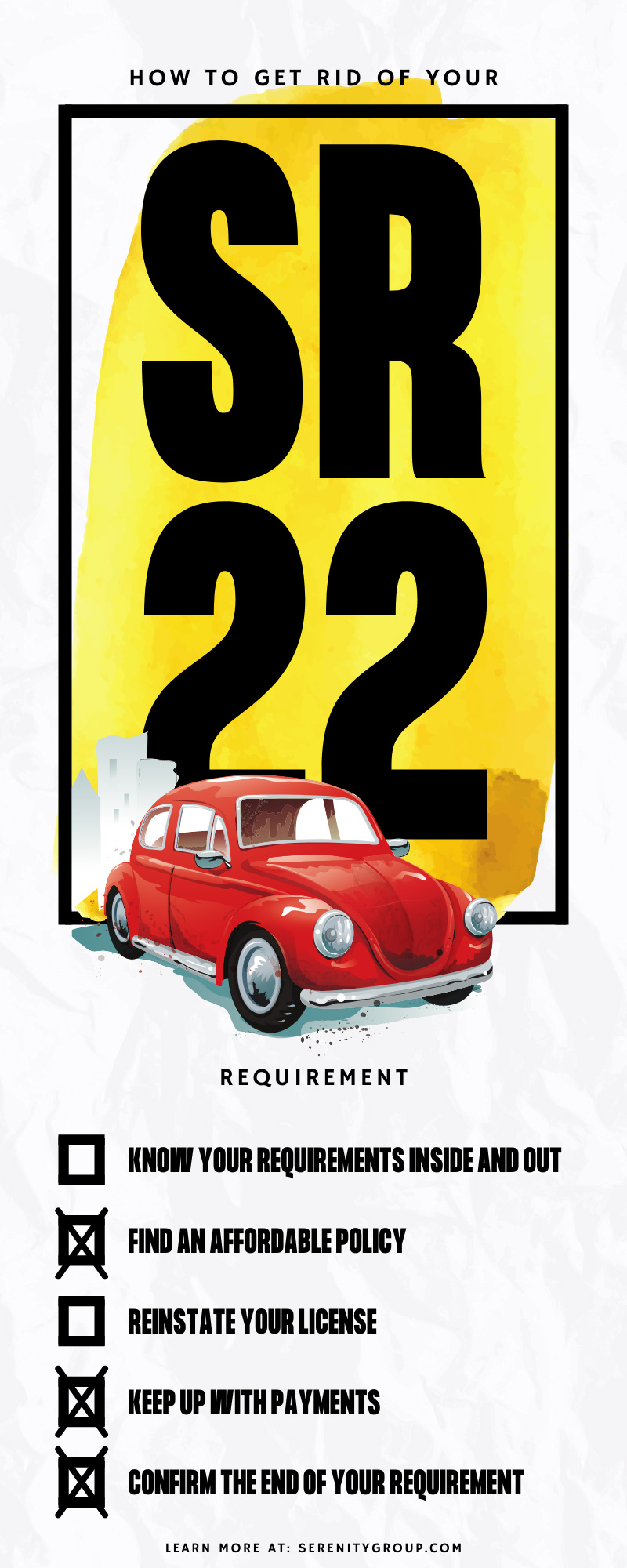How To Get Rid Of Your SR22 Requirement

Accidents happen. Even the best drivers can make mistakes on the road. When something goes wrong and you’re the one responsible, the best thing you can do is face the consequences. In the case of car accidents and traffic violations, one of those consequences is an SR22 insurance policy. States use SR22 insurance requirements to ensure that high-risk drivers maintain the minimum liability coverages on their auto insurance policies. In many scenarios, you’ll also need an SR22 insurance policy to reinstate a suspended license.
Unfortunately for drivers, an SR22 insurance policy can raise your premium and make auto insurance more expensive. However, this doesn’t mean you can just cancel your policy and move on with your life. To make your SR22 requirement as stress-free as possible, you need to learn more about your policy and make payments responsibly. From receiving the requirement to taking the coverage off your auto insurance policy, here’s our guide on how to get rid of your SR22 requirement the right way.
Know Your Requirements Inside and Out
Many people have never even heard of SR22 insurance before obtaining their own policy. Without the right knowledge, SR22 insurance can seem daunting. What does it mean? How will it affect your insurance? How will it affect the rest of your life? Taking the time to learn more about your policy can make the entire process easier. In most scenarios, an SR22 requirement identifies you as a high-risk driver. Insurance providers are more hesitant to cover risky drivers, which means they’ll offer you higher insurance rates. An SR22 policy can raise your premium by up to 40 percent. Your state’s minimum liability requirements determine the exact cost of your SR22 policy. Additionally, every state has different laws about how long an SR22 requirement lasts. You must maintain SR22 coverage throughout the entirety of your requirement, which can last anywhere from one to five years depending on where you live. Once you know more about the requirement you’re facing, you can use that information to find a fair and affordable insurance policy.
Find an Affordable Policy
Not all insurance providers are the same. Some are more lenient with high-risk drivers while others don’t offer SR22 insurance at all—even to existing policyholders. When you receive your SR22 requirement, make sure you find a good provider. Once you have all the information you need about your specific requirement, take the time to compare quotes from different auto insurance companies that offer SR22. Serenity Group can help you sort through the details of potential policies to find the best deal possible. As you build your policy, look for discounts and offers that can offset the cost of your SR22 requirement. For example, you might be able to save money by paying for the entire policy upfront. Many insurance providers also offer discounts for good students, senior citizens, or individuals who have fewer annual miles than the average driver.
Reinstate Your License
One of the most frustrating and inconvenient parts of an SR22 requirement is losing your license. Driving to work, running errands, or picking up friends or family become incredibly stressful when you lose your most reliable method of transportation. The good news is that purchasing your SR22 insurance policy takes you one step closer to getting your license back. Once you meet your insurance requirements and wait the proper amount of time, the DMV will reinstate your license and allow you to return to the road. This is a major weight off your shoulders and helps you get back to a state of normalcy after your traffic violation.
Keep Up With Payments
Unfortunately, reinstating your license doesn’t mean your policy is over. You must keep up with your SR22 insurance to avoid a policy lapse. If you don’t keep up with it, your provider will notify the state. In most cases, the state will suspend or revoke your license again. This means your SR22 process will start over. All the time you’ve spent paying for your policy will be for nothing. Be careful and keep up with your policy throughout the duration of your requirement. If you have to switch providers—either to move out of state or find a better policy—make sure your new SR22 insurance policy is in place before canceling your original insurance.
Prevent Future Incidents
Repeat offenses are almost always worse than first offenses. While the consequences of a first-offense DUI or other traffic violation are steep, you’ll face more severe repercussions for future incidents. An SR22 requirement can serve as a wake-up call about your driving habits. During your policy, avoid committing another traffic violation so that you don’t have to go through the process again. Invest in your driving skills by taking defensive driving courses, keeping your vehicle in good shape, and using designated drivers or alternative means of transportation when you drink.
Wait It Out
Once you’re on track with your SR22 requirement, the only thing left to do is be patient. Maintain your insurance policy, stay safe and responsible on the road, and avoid a policy lapse or violation that will force you to repeat the process. While maintaining your SR22 insurance can be frustrating—especially for policies that last multiple years—fulfilling these obligations is the only way to get rid of your SR22 requirement. Stay on top of your requirements and make your payment diligently so that you can remove your SR22 policy as quickly as your state allows.
Confirm the End of Your Requirement
Once you’ve reached the end of your SR22 requirement, you can remove the coverage from your insurance policy. Be careful about this last step. Even if you’re certain you’ve met your requirements, you should always call your DMV to confirm that your policy is over. Keep in mind that the end of your SR22 requirement doesn’t mean it automatically disappears from your insurance policy. Once the DMV confirms that you no longer need SR22 insurance, you must notify your auto insurance provider so that they can remove the coverage from your policy. Once they do so, you can enjoy your life as an SR22-free driver.


Recent Comments